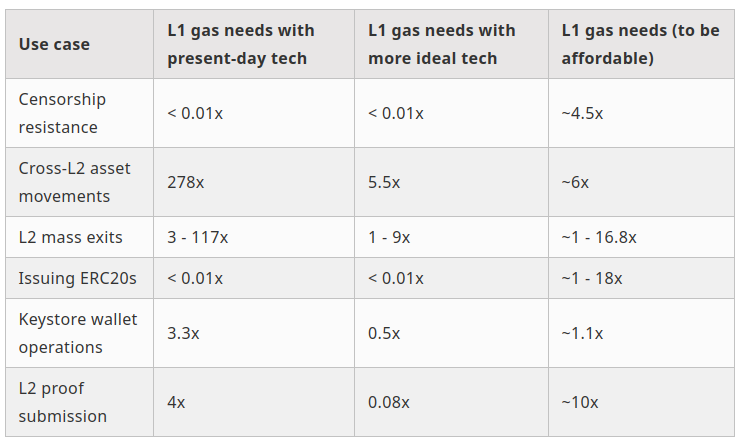Vitalik Buterin has argued that growing Ethereum’s L1 fuel capability is critical to help transaction inclusion and utility improvement when most exercise happens on L2. In a brand new weblog publish, Buterin outlined calculations suggesting {that a} roughly 10× growth in L1 capability would protect key community capabilities whilst functions migrate to Layer 2 options.
The fuel restrict defines the utmost quantity of computational work that may be carried out in a single block, setting an higher sure on the transactions and operations processed. Rising the fuel restrict expands the protocol’s capability to course of extra computational work per block, permitting it to deal with a better quantity of transactions and extra complicated operations whereas influencing charge dynamics.
Current 20% improve in fuel restrict
Buterin’s evaluation builds on the latest improve within the L1 fuel restrict from 30 million to 36 million, which raises capability by 20%.
Buterin famous that additional will increase, enabled by effectivity enhancements in Ethereum shoppers, diminished historical past storage from EIP-4444, and eventual adoption of stateless shoppers, may supply long-term advantages. His dialogue frames the controversy over scaling by evaluating present fuel wants with extra ideally suited situations throughout a number of use circumstances.
As Buterin reported, censorship resistance stays a crucial perform. He demonstrated that bypass transactions—designed to beat potential censorship on L2—may value roughly $4.50 at present fuel costs. By scaling L1 capability by roughly 4.5×, these prices may very well be pushed down, guaranteeing that legitimate transactions attain the blockchain promptly even below congestion. In the same vein, cross-L2 asset actions, together with transfers of high-volume belongings and NFTs, presently incur prices close to $14 per operation.
Buterin’s estimates recommend that with improved design and a scaling issue of about 5.5× to six×, such transactions is likely to be executed at a fraction of that value, probably as little as $0.28 in a super setup.
Mass exits from L2s
Buterin’s evaluation extends to situations involving mass exits from L2. An exit refers back to the operation by which customers withdraw their belongings from a Layer 2 resolution again to Ethereum’s predominant chain (L1), usually to safeguard funds throughout community disruptions or different emergencies.
He calculated that below present parameters, an exit requiring 120,000 fuel per consumer would permit between 7.56 million and 32.4 million customers to exit over a one-week to 30-day interval, relying on the roll-up design. With optimized protocols—lowering the price per exit operation to roughly 7,500 fuel—the variety of customers in a position to exit safely may improve considerably, supporting hundreds of thousands extra and lowering the danger of liquidity or safety points during times of community stress.
Addressing token issuance, Buterin noticed that many new ERC20 tokens are launched on L2. Nevertheless, tokens issued on L2 could also be susceptible if a hostile governance improve happens, a danger mitigated by launching on L1. He cited examples such because the deployment of the Railgun token, the place the price was over 1.6 million fuel.
Even when these prices had been diminished to round 120,000 fuel, the expense per issuance stays close to $4.50, implying {that a} scaling issue as much as 18× may very well be required for extra widespread, cost-effective token launches that meet decrease goal charges.
The dialogue additionally coated operations tied to keystore wallets. Buterin estimated that for widespread key updates—assuming 50,000 fuel per operation—a 3.3× improve in fuel capability is likely to be wanted, although effectivity features lowering the price to round 7,500 fuel per operation may decrease this requirement to almost 1.1×.
Equally, frequent L2 proof submissions, vital for sustaining up-to-date interoperability between chains, presently impose substantial prices that restrict the variety of viable L2s. With superior aggregation protocols probably decreasing per-submission prices to about 10,000 fuel, a scaling issue of roughly 10× could be wanted to make common L2-to-L1 updates economically viable.

Buterin’s calculations spotlight that regardless of most exercise shifting to L2, sustaining sturdy L1 performance is crucial to protect censorship resistance, allow environment friendly asset transfers, help mass exits, safeguard token issuance, and facilitate interoperability.
As Buterin concluded, growing L1 fuel capability affords worth by guaranteeing that basic blockchain operations stay safe and accessible whilst community utilization patterns evolve.
His evaluation frames a transparent argument for near-term scaling measures that might safeguard Ethereum’s core capabilities whatever the long-term steadiness between L1 and L2 exercise.
Talked about on this article


